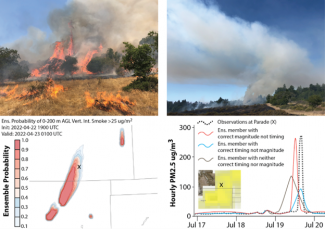With wildfires increasingly impacting society and ecosystems spanning local to global scales, NOAA has expanded its strategic investments and plans to address wildfire-related hazards. In 2023, NOAA established a new Fire Weather Testbed (FWT), a joint effort between three of NOAA’s Line Offices: NOAA Research (Oceanic and Atmospheric Research), NOAA Satellites (National Environmental Satellite, Data, and Information Service), and the National Weather Service. Housed within NOAA’s Global Systems Laboratory in Boulder, Colorado, the FWT will comprise physical and virtual facilities for conducting evaluations and experiments to facilitate the transfer of new technologies and applications into operational platforms as quickly as possible.
The FWT will convene a broad range of fire-related communities across agencies and jurisdictions, including decision makers, researchers, and operational fire weather forecasters to improve and tailor tools, applications, products, and information. A primary focus centers on understanding the information needs of stakeholders involved with wildland fire before, during, and after the flames to create a fire-ready nation: one that is fire-adapted and fire-resilient.
One of the unique goals of the FWT will be a thorough “User Needs Assessment” of the fire-weather community to better understand the needs and gaps impacting the front-line firefighters and decision makers across the many timelines (instantaneous to seasonal) pertinent to fire management. The FWT is also hiring multiple Social and Behavioral Scientists to ensure that relevant social science is incorporated throughout the evaluation process, from designing and facilitating evaluations to ensuring user feedback is incorporated into new tools and technologies. Social science will guide the development of new tools so that they are effective in helping operational decision-makers understand often complex weather forecasts to make well-informed decisions amidst uncertainties typical in wildland fire situations.
One of the many significant challenges to improving fire-weather forecasts is that wildland fires often begin in complex terrain with very sparse data observations. This combination of mountainous geography, varying vegetation types, and lack of observations makes it difficult to observe, much less accurately model and skillfully forecast, weather near wildfires. To successfully model weather in these complex environments, we need high-quality data and verification. The FWT will work closely with other NOAA Testbeds and Proving Grounds to facilitate the evaluation and transition of state-of-the-art wildfire weather-related products and tools..
Fire weather forecasting includes many aspects requiring verification. Upper left: Fire behavior, spread, and emissions are dependent on local and regional weather including humidity, temperature, wind, radiation, vegetation (fuel), and topography. Upper right: Skillful forecasts of upslope winds (flow from left to right), transport winds (flow from right to left), and mixing height forecasts are critical to estimate dispersion and transport from wildland fires. Lower left: New ensemble forecasts, such as the Warn-On-Forecast Smoke system developed by the National Severe Storms Laboratory, can provide probabilistic guidance for values-at-risk, such as the location of a parade (X) that has a 50% chance of experiencing problematic ground-level smoke concentrations. Lower right: Verification of forecasts using remotely sensed data (inset shows the Suomi NPP Aerosol Index) and in situ observations (main) will improve our ability to predict and communicate impactful fire weather-related conditions that ultimately protect life and property.
The FWT and the Developmental Testbed Center (DTC) will collaborate to ensure that the most advanced verification methods and techniques and technologies are being tested and implemented in fire weather-based forecasting within the Unified Forecast System (UFS). For example, the DTC is currently working on adding verification capabilities to the enhanced Model Evaluation Tools (METplus) software system, as well as testing methods within the Short-Range Weather App. The DTC will build on antecedent air quality evaluation efforts to include the ability to assess the Rapid Refresh Forecast System (RRFS)-Smoke forecasts of PM2.5, PM10, and aerosol optical depth forecasts within METplus. Once verification of these fields is finalized, METplus use-cases, or examples, will be added to the SRW App for future use by the general modeling community, including the FWT. Tools such as the Method for Object-based Diagnostics Evaluation (MODE) will be used by the Short Range, Medium Range, Subseasonal to Seasonal (S2S), and the Seasonal Forecast System (SFS) to evaluate precursor fields such as precipitation, and atmospheric moisture. It will also help evaluate fire parameters such as spread and impact of short term atmospheric phenomena.
The DTC provided two training series on how to configure METplus for fire weather in November 2023. The recordings and presentations can be found on the DTC website.

